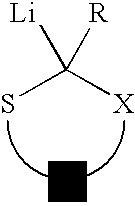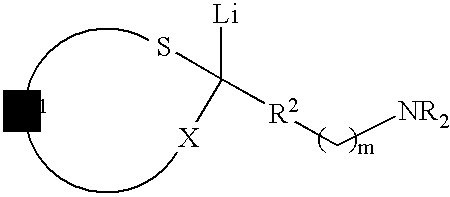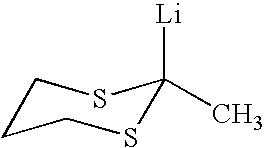Use of sulfur containing initiators for anionic polymerization of monomers
a monomerization and anionic polymerization technology, applied in the field of functionalized polymers and rubber vulcanizates, can solve the problems of hysteresis loss, no use of sulfur containing initiators, especially lithium thio acetal based compounds, and is known
- Summary
- Abstract
- Description
- Claims
- Application Information
AI Technical Summary
Benefits of technology
Problems solved by technology
Method used
Image
Examples
example no.1
Example No. 1
Synthesis of 2-lithio-2-methyl-1,3-dithiane
[0086]To a 0.8 L N2 purged bottle equipped with a serum cap was added 350 mL of dried tetrahydrofuran and 10 mL of 2-methyl-1,3-dithiane (83.5 mmol). The bottle was cooled to −78° C. and 55.83 mL of 1.510 M butyllithium (84.3 mmol) in hexane was added. The reaction was stirred at −78° C. for 3 hours and then stored at −25° C. overnight. Titration of the resulting solution indicated that the solution contained 0.234 M active lithium compound. To elucidate the structure of this compound, the solution was added to a dried solution of 8.26 mL of 1-bromo-3-chloropropane (83.5 mmol) in 90 mL tetrahydrofuran at −78° C. After 3 hours, the products were examined by GC / MS and found to contain >95% 2-(3-chloropropyl)-2-methyl-1,3-dithiane. No 1-chloroheptane was observed indicating that the butyllithium had completely reacted with the 2-methyl-1,3-dithiane.
example no.2
Example No. 2
Synthesis of Poly(styrene-cobutadiene) with 2-lithio-2-methyl-1,3-dithiane
[0087]To a 1.75 L N2 purged reactor equipped with a stirrer was added 1.12 kg of hexane, 0.48 kg of 33 wt % styrene in hexane, and 2.89 kg of 22.0 wt % butadiene in hexane. The reactor was then heated to 24° C. and 0.5 mL of 1.6 M of a cyclic oligomeric oxolanyl alkane modifier, in hexane and 22.63 mL of 0.234 M 2-lithio-2-methyl-1,3-dithiane in tetrahydrofuran was charged to the reactor. The reactor jacket was then heated to 54° C. After 15 minutes, the batch temperature peaked at 76.5° C. After an additional 25 minutes, the cement was removed from the reactor, coagulated in isopropanol containing butylated hydroxy toluene (BHT), and drum dried to yield a polymer with the following properties: Mn=153 kg / mol, Mw=167 kg / mol, Tg=−44.4° C., 21.7% styrene, 1.3% block styrene, 32.1% vinyl, and 46.2% 1,4 butadiene incorporation.
example no.3
Example No. 3
Synthesis of Poly(styrene-co-butadiene) with 2-lithio-2-methyl-1,3-dithiane
[0088]To a 1.75 L N2 purged reactor equipped with a stirrer was added 1.12 kg of hexane, 0.48 kg of 33 wt % styrene in hexane, and 2.89 kg of 22.0 wt % butadiene in hexane. The reactor was then heated to 24° C. and 0.5 mL of 1.6 M of cyclic oligomeric oxolanyl alkane modifier in hexane and 16.96 mL of 0.234 M 2-lithio-2-methyl-1,3-dithiane in tetrahydrofuran was charged to the reactor. The reactor jacket was then heated to 54° C. After 17 minutes, the batch temperature peaked at 75.7° C. After an additional 10 minutes, the cement was removed from the reactor, coagulated in isopropanol containing butylated hydroxy toluene (BHT), and drum dried to yield a polymer with the following properties: Mn=208 kg / mol, Mw=240 kg / mol, Tg=−43.8° C., 22.2% styrene, 1.6% block styrene, 31.2% vinyl, and 46.5% 1,4 butadiene incorporation.
PUM
| Property | Measurement | Unit |
|---|---|---|
| temperature | aaaaa | aaaaa |
| temperature | aaaaa | aaaaa |
| temperature | aaaaa | aaaaa |
Abstract
Description
Claims
Application Information
 Login to View More
Login to View More - R&D
- Intellectual Property
- Life Sciences
- Materials
- Tech Scout
- Unparalleled Data Quality
- Higher Quality Content
- 60% Fewer Hallucinations
Browse by: Latest US Patents, China's latest patents, Technical Efficacy Thesaurus, Application Domain, Technology Topic, Popular Technical Reports.
© 2025 PatSnap. All rights reserved.Legal|Privacy policy|Modern Slavery Act Transparency Statement|Sitemap|About US| Contact US: help@patsnap.com



